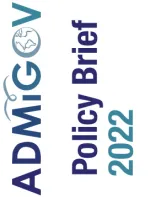Measuring good migration governance using the ADMIGOV indicators

ADMIGOV Policy Brief (December 2022)
How can we move forward to implement more secure, more sustainable, and more efficient migration governance? To what extent are current migration governance systems efficient, effective, and based on evidence and evaluation? Are migration governance systems consistent with the principles of protection and sustainable development as laid out in UN frameworks? What are the current strengths and weaknesses of current migration governance systems with respect to migrant protection and sustainable development? And to what extent are current migration governance systems able to bring into practice what is committed to on paper? The AdMiGov Indicators of Good Migration Governance present a tool that can be applied, tested and refined by different stakeholders to investigate these urgent questions.
The evidence supporting the notion that current systems of migration governance are lacking in critical areas is regrettably all too apparent. The numbers of deaths at the Greek and Italian sea borders, pushbacks at the Polish-Belarus border and in Melilla (Spain) and miserable conditions in the outdoor asylum camp in Ter Apel (Netherlands) are shameful examples of failures in migration governance systems, and draw further attention to the need for better migration governance. Introducing an innovative methodology, the AdMiGov indicators offers policy makers, academics and other interested stakeholders a tool to assess national migration governance systems in accordance with the principles of protection and sustainable development, while additionally moving beyond a traditional focus on policies on paper. The 68 indicators that make up the tool assist policy makers to identify governance gaps including normative gaps (the gaps between normative principles and policies on paper) and implementation gaps (temporal, geographical and by target population) which are assessed based on how systematically migration governance is put into practice. The indicators approach the notion of good migration governance in a holistic way, assessing governance practices such as the systematic use of evidence in the policy process, access of non-governmental stakeholders to the policy process and the transparency of information made available by the government on its practices.